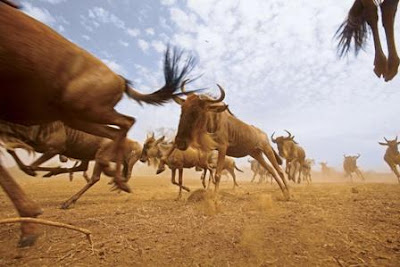Breathtaking! Awesome! Amazing!
Seriously, those are just some of the words that came to mind while I watched the press screening of Born to Move a couple of weeks ago.
This first episode of Great Migrations, to premier in National Geographic Channel tomorrow night, shows four remarkable animal movements that happen every year. Watch thousands of Wildebeest travel across a wide expanse of desert; pause to give birth to their young; go on again with their journey of following the rain; and make a river crossing where hungry crocodiles wait.
Next, be awed at the sight of a red moving mass of air-breathing crabs traveling along the forest floor of Christmas island going towards the sea of their birth to breed and propagate the next generation. I'm pretty sure you'll also dislike the yellow crazy ants they would meet along the way.
Marvel at the sight of thousands upon thousands of monarch butterflies stretching their wings after a long winter rest. This part is where I appreciated the slow motion effects the most. I also enjoyed learning that it takes four generations of these beautiful creatures to cross a continent (from Mexico to Canada) so that they can breed a fifth super generation that will travel the thousands of miles back to Mexico in time to rest for another winter. Imagine, having that kind of migratory instinct and pattern imprinted in your DNA?!
Lastly, Born to Move tells the story of sperm whales that travel over a million miles in their lifetime. It's a bit funny to note that females travel in groups while males prefer to be alone (of course, except during mating season). Maybe the guys didn't want to be surrounded by all the chatter :p
I really recommend that parents watch Great Migrations with their kids. I am very grateful to be given a DVD of Born to Move by NGC because my husband and kids were as amazed as I was when they got to watch part one in all its full-color, high-definition glory. Now, we can't wait to watch the rest of Great Migrations! For sure, we'll be glued to the National Geographic Channel every 9 p.m. for the next seven Sundays. I am particularly very interested to watch the Behind the Scenes episode on Dec. 12.
Synopsis
Move as millions. Survive as one. National Geographic Channel’s Great Migrations gives the word “move” a whole new meaning. This seven-part global programming event takes viewers around the world on the arduous journeys millions of animals undertake to ensure the survival of their species.
Shot from land and air, in trees and cliff-blinds, on ice floes and underwater, Great Migrations tells the formidable, powerful stories of many of the planet’s species and their movements, while revealing new scientific discoveries with breathtaking high-definition clarity. The miraculous red crab migration on Christmas Island. Flying foxes in Australia and army ants in Costa Rica. Wildebeest, great white sharks, zebra and Mali elephants. Microscopic plankton and jellyfish in Indonesia. The first radio transmitter attached to a monarch butterfly. The first film crew on the ground in Sudan in 25 years, there to capture the migration of the white-eared kob.
The beauty of these stories is underscored by new knowledge of these species’ fragile existence and their life-and-death quest for survival in an ever-changing world. The all-National Geographic Great Migrations team spent two and a half years in the field, travelling 670,000 kilometres in 120 countries and all seven continents to bring this spectacular first-of-its-kind production to television in Fall 2010.
For the complete lineup of shows, descriptions, trivia, etc. please check out the complete press release I posted in my other blog. Again, don't forget to watch Born to Move tomorrow night!













No comments:
Post a Comment